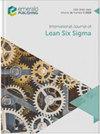Readiness level assessment for lean Six Sigma implementation in the healthcare sector
IF 3.7
2区 工程技术
Q2 ENGINEERING, INDUSTRIAL
引用次数: 0
Abstract
Purpose The purpose of this study is to identify the critical readiness factors (CRFs) that mainly affect the implementation of Lean Six Sigma (LSS) in an organization and their interactions, and to develop a model that allows the management to assess the Lean Implementation Readiness Level. Design/methodology/approach The methodology is separated into two main parts: the literature review and the assessment model development. In the literature review, the main CRFs and their interactions for LSS implementation in Scopus Data Base were identified. The second part of the methodology is the model development. It was built on a stepwise framework that considers the relations among the CRFs and their importance. Moreover, it was used fuzzy-based linguistic variables given by the experts working in the company to consider the actual performance rating of each CRF. The model has been validated in the healthcare sector in nine hospitals. Findings From the model application, it is possible to note that the most frequent level among the nine hospitals interviewed is “Average Ready”. Also, the most extreme level of readiness occurred ones while the most extreme level of not readiness never occurred. Results show that in 78% of the cases, there would have been a high probability of implementation failure. Also, it was possible to identify for each hospital if the CRFs are good, if they are weak and need to change or if another factor needs to be improved before it and what this factor is. Originality/value This work proposes a new methodology that eliminates the negative aspects and limitations of the total interpretive structural modeling methodology and the fuzzy logic approach currently applied to evaluate the LSS readiness of a company. The present methodology lies in the fact that it provides a solution not only by defining the weak CRFs but also by giving an indication of priority as it identifies the weak antecedent factors that inhibit the preparedness of the depending factors.医疗保健行业实施精益六西格玛的准备程度评估
本研究的目的是识别主要影响组织实施精益六西格玛(LSS)的关键准备因素(CRFs)及其相互作用,并建立一个模型,使管理层能够评估精益实施准备水平。方法分为两个主要部分:文献综述和评估模型开发。在文献综述中,确定了在Scopus数据库中实施LSS的主要crf及其相互作用。方法论的第二部分是模型开发。它是建立在一个逐步的框架之上的,该框架考虑了CRFs之间的关系及其重要性。此外,它还使用公司专家给出的基于模糊的语言变量来考虑每个CRF的实际性能评级。该模型已在9家医院的医疗保健部门得到验证。从模型应用中,可以注意到受访的九家医院中最常见的水平是“平均准备”。此外,最极端的准备状态发生了,而最极端的不准备状态从未发生过。结果表明,在78%的案例中,实施失败的概率很高。此外,还可以确定每家医院的CRFs是否良好,是否较弱且需要改变,或者是否需要在此之前改善另一个因素,以及这个因素是什么。这项工作提出了一种新的方法,消除了总解释结构建模方法和模糊逻辑方法的消极方面和局限性,目前用于评估公司的LSS准备情况。目前的方法在于,它提供了一种解决办法,它不仅确定了弱的综合评价指标,而且还指出了优先次序,因为它确定了阻碍依赖因素准备的弱的先决因素。
本文章由计算机程序翻译,如有差异,请以英文原文为准。
求助全文
约1分钟内获得全文
求助全文
来源期刊

International Journal of Lean Six Sigma
Engineering-Industrial and Manufacturing Engineering
CiteScore
8.90
自引率
15.00%
发文量
46
期刊介绍:
Launched in 2010, International Journal of Lean Six Sigma publishes original, empirical and review papers, case studies and theoretical frameworks or models related to Lean and Six Sigma methodologies. High quality submissions are sought from academics, researchers, practitioners and leading management consultants from around the world. Research, case studies and examples can be cited from manufacturing, service and public sectors. This includes manufacturing, health, financial services, local government, education, professional services, IT Services, transport, etc.
 求助内容:
求助内容: 应助结果提醒方式:
应助结果提醒方式:


